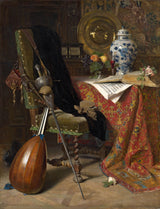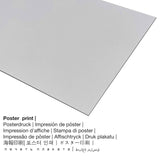Charles Gifford Dyer, 1877 - Seventeenth-Century Interior - fine art print
Tax included. Shipping calculated at checkout.
The modern art artwork was made by the male artist Charles Gifford Dyer. The piece of art measures the size: 94 × 71,1 cm (37 × 28 in) and was painted with the medium oil on canvas. "Signed, l.l.: "CHARLES G. DYER: MUNICH 1877."" was the artpiece's inscription. This artpiece is included in the art collection of Art Institute Chicago in Chicago, Illinois, United States of America. We are glad to mention that the public domain artwork is included with courtesy of Art Institute Chicago. Creditline of the artwork: Gift of the Estate of Henry W. King. Moreover, alignment is in portrait format with a ratio of 3 : 4, which means that the length is 25% shorter than the width.
Choose your material
The product dropdown menu gives you the opportunity to pick your prefered size and material. Choose among the following product options now to match your preferences in size and material:
- The poster print on canvas material: The poster is a UV printed cotton canvas paper with a nice structure on the surface, which resembles the actual version of the work of art. The poster print is ideally used for putting your art print using a custom-made frame. Please note, that depending on the absolute size of the poster we add a white margin of around 2 - 6cm round about the print, which facilitates the framing with a custom frame.
- Canvas print: The canvas print is a printed cotton canvas mounted on a wooden frame. Furthermore, a canvas print creates a lively and pleasing impression. Your canvas print of your favorite work of art will give you the opportunity of turning your individual into a large size artwork. Hanging a canvas print: A canvas print has the great advantage of being low in weight. That means, it is easy to hang your Canvas print without extra wall-mounts. A canvas print is suited for all kinds of walls.
- Acrylic glass print (with real glass coating): A glossy print on acrylic glass, which is sometimes described as a UV print on plexiglass, will change the artwork into beautiful décor. The work of art will be custom-made with state-of-the-art UV direct print technology. This has the effect of vivid and deep colors. The major upside of an acrylic glass art print is that sharp contrasts and minor artwork details become more recognizeable thanks to the very subtle gradation. Our plexiglass with real glass coating protects your custom fine art print against light and heat for decades.
- Aluminium dibond print: Aluminium Dibond prints are prints on metal with an outstanding depth effect - for a modern look and non-reflective surface. For our Print On Aluminum Dibond, we print your chosen work of art right onto the surface of the white-primed aluminum composite. The bright and white parts of the original artwork shimmer with a silky gloss, however without the glow. The direct UV print on Aluminum Dibond is the most popular entry-level product and is an extremely modern way to display artworks, since it draws focus on the whole artwork.
Legal disclaimer: We try our utmost in order to describe our products with as many details as possible and to illustrate them visually in our shop. Still, the tone of the print materials and the printing may diverge slightly from the image on your device's monitor. Depending on the screen settings and the condition of the surface, colors might not be printed 100% realistically. Given that all the fine art prints are processed and printed by hand, there may as well be minor variations in the exact position and the size of the motif.
Product details
| Article classification: | fine art reproduction |
| Reproduction: | digital reproduction |
| Manufacturing method: | digital printing |
| Origin of the product: | made in Germany |
| Stock type: | production on demand |
| Proposed product use: | home décor, wall picture |
| Alignment of the artwork: | portrait alignment |
| Side ratio: | 3 : 4 |
| Aspect ratio interpretation: | the length is 25% shorter than the width |
| Available choices: | poster print (canvas paper), metal print (aluminium dibond), canvas print, acrylic glass print (with real glass coating) |
| Canvas print (canvas on stretcher frame) size variants: | 30x40cm - 12x16", 60x80cm - 24x31", 90x120cm - 35x47", 120x160cm - 47x63" |
| Acrylic glass print (with real glass coating) size variants: | 30x40cm - 12x16", 60x80cm - 24x31", 90x120cm - 35x47", 120x160cm - 47x63" |
| Poster print (canvas paper) size variants: | 30x40cm - 12x16", 60x80cm - 24x31", 90x120cm - 35x47" |
| Dibond print (alumnium material) variants: | 30x40cm - 12x16", 60x80cm - 24x31", 90x120cm - 35x47" |
| Art print framing: | please bear in mind that this art print does not have a frame |
Artwork table
| Work of art title: | "Seventeenth-Century Interior" |
| Artwork classification: | painting |
| General term: | modern art |
| Century: | 19th century |
| Created in: | 1877 |
| Age of artwork: | around 140 years old |
| Medium of original artwork: | oil on canvas |
| Size of the original artpiece: | 94 × 71,1 cm (37 × 28 in) |
| Signature: | signed, l.l.: "CHARLES G. DYER: MUNICH 1877." |
| Exhibited in: | Art Institute Chicago |
| Museum location: | Chicago, Illinois, United States of America |
| Museum's webpage: | Art Institute Chicago |
| License: | public domain |
| Courtesy of: | Art Institute Chicago |
| Creditline: | Gift of the Estate of Henry W. King |
About the painter
| Artist: | Charles Gifford Dyer |
| Alias names: | Charles Gifford Dyer, Dyer gifford, Dyer Charles Gifford |
| Gender of the artist: | male |
| Artist nationality: | American |
| Jobs of the artist: | painter |
| Country: | United States |
| Artist category: | modern artist |
| Died aged: | 66 years |
| Born: | 1846 |
| Town of birth: | Chicago, Cook county, Illinois, United States |
| Year of death: | 1912 |
| Died in (place): | Munich, Bavaria, Germany |
© Copyrighted by, Artprinta.com (Artprinta)
Additional specifications by Art Institute Chicago website (© Copyright - by Art Institute Chicago - www.artic.edu)
Chicagoan Charles Gifford Dyer studied painting in Paris and Munich. The objects depicted in this canvas, such as the Chinese blue-and-white vase and Oushak Turkish lotto rug, were likely collected during his extensive travels and represent the tastes of a worldly, wealthy man. The painting recalls 17th-century Dutch compositions in its focus on surfaces, textures, and illusionism. Like moralistic Dutch still life paintings, it evokes the fleetingness of life (vanitas) by juxtaposing objects that quickly decay, such as fruit and flowers, with the enduring arts of literature and music. The crisscross pattern of the parquet floor and the draped rug create spatial depth, offering a portrait of the Gilded Age, a time when an expanding economy encouraged the rich to collect such treasures.














